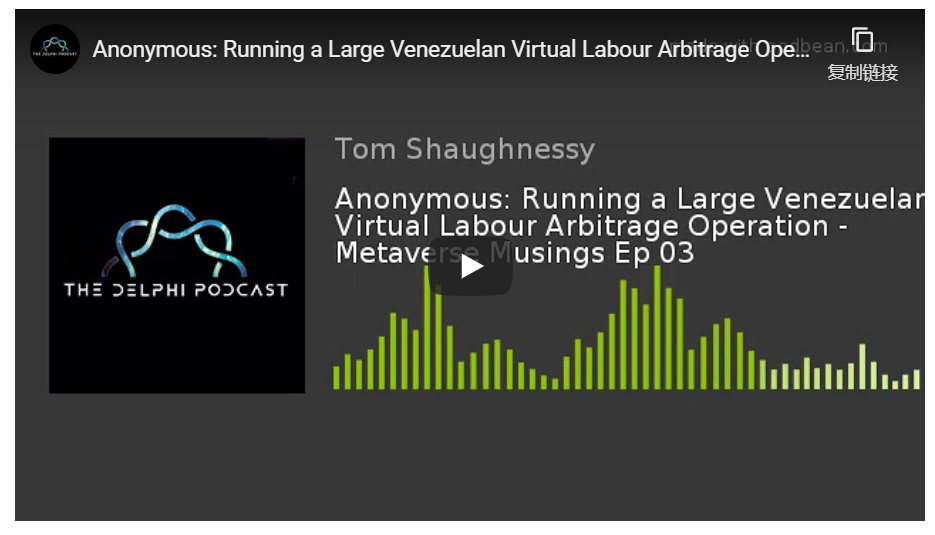
推广DAO理念,并帮助更多的人投入价值创造实践
Detailed explanation of NFT mining
Summary:: Take you through the future of billions of dollars in new opportunities every year
Word Count: 1631
Author: Andrew Steinwold
Translated by Frau Yang
Proofreading: Dashuo
Translation agency: DAOSquare

When the economy in the game is large enough, people start making money in the game to make a living. This kind of activity is called gold mining in Internet games, but it is called yield farming in the blockchain field, which is generally translated as "mining" in China. It is characterized by players acquiring in-game currency and intending to sell it. Swap for "real world" money. (Translator's Note: The two terms, gold mining and mining, will be mixed in the following content, but they have the same meaning.)

I'm very excited to announce the first sponsor of the Zima Red newsletter! My good friend Digital. Digital is an amazing creator who tokenizes his art and music. He is constantly on the cutting edge, and you can see it all on his website Danky.Art. Be sure to sign up for his newsletter, where he sends updates on a digital artist's journey to harness the power of Ethereum. Sign up here - Digital Newsletter.
Goldsmithing is often looked down upon by game developers because users earn a living by playing their games. Let’s be honest, most game developers don’t like the impact gold has on the game economy. In addition, there are many regulatory issues involving real-world currency flows, and game developers will definitely want to avoid problems with financial regulators.
For these reasons, game developers have always banned gold mining, and will block a batch of related accounts every once in a while. Still, we can see large, hand-operated goldsmithing studios all over the world. These operations, often found in low-income countries, provide a valuable service to locals and gamers: they hire locals for relatively high-paying jobs, while letting developed regions of players get better gear and opportunities quickly without spending 100+ hours.
If anyone wants to learn more about the day-to-day operations of a modern Venezuela-based studio, then I highly recommend checking out the Delphi Podcast, which has a series Metaverse Musings on the subject. My good friend Piers Kicks from Delphi Digital had a conversation with a Runescape gold studio lead, and this audio sounded very interesting.

a new era
Fortunately, we are at the dawn of a new era in which gold mining will finally be seen as a normal activity rather than a grey industry. Virtual worlds and games are being created on an uncensorable global financial system called blockchain, which enables users to have real property rights in the digital world. Importantly, the blockchain gives users the freedom to acquire items and transact with anyone, with complete confidence not to worry about having their accounts suspended. This is possible because all game assets are actually on the blockchain, which is the native financial infrastructure. This means that user buying and selling can happen anytime, anywhere and cannot be blocked.
If the blockchain achieves all this, what does it mean for "mining" in the NFT world? In short, we are on the precipice of a massive shift in NFT mining. Over the next few years, we will see NFT mining operations rivaling the earlier Bitcoin mining operations in terms of scale and potential revenue generation.
The main difference between NFT mining and Bitcoin mining will be greenhouse gases! Half kidding). NFT mining will be powered by people in low-income countries (at least for now, more on that later), while Bitcoin mining will be powered by machines. Both will provide tremendous value to the web, gaming, and even gold-playing studios. Perhaps most importantly, NFT mining will also provide value to the employees performing the mining, as wages for all types of gold mining operations tend to be well above any minimum wage in their region/country.
hit gold
So what does an NFT mining operation look like? In fact, people play games in order to obtain game currency or NFTs. An example of this type of activity occurred in the NFT game Axie Infinity. There are a lot of people playing Axies in the Philippines for the sole purpose of getting something called "Small Love Potions" or SLP, and these tokens are used to breed more Axies. CoinDesk has a great article covering this issue in more detail.
SLP has a continuous and stable demand. As a crypto token, it can be traded on any venue that accepts it and "withdrawn" from the Axie ecosystem. Holders and goldsmiths can take their assets anywhere. This means that value is not limited to "in-game", unlike almost every other traditional game where you can get in-game currency and merchandise, but can't take them out of the ecosystem or even sell them for real money.
Mining in Axie Infinity is ideal because in this case miners have a choice: they can keep mining SLP tokens to sell, or use SLP tokens to breed other Axies that have their own value. Today, such mining opportunities are rare in the NFT world, but I am very confident that the next few years will see a massive increase in NFT mining, especially with the rise of new token models.
Governance Token Mining
The COMP token, launched by the money market protocol Compound, tells us that a successful product can launch crypto tokens to incentivize specific user behaviors. COMP is used to reward users who provide liquidity to their asset pools or lend assets from their liquidity pools. This token opened people’s eyes and helped them understand that users can have real upside in a platform’s success. Suddenly, people started rolling out tokens that reward users for doing X and Y activities.
Rarible, an NFT art platform, has launched the first token directly related to the NFT ecosystem, called the RARI token. This token rewards users based on their transaction volume on Rarible, also known as transaction mining. This token economy system has been a huge success, and we saw Rarible dominate the NFT market almost overnight. Rarible's meteoric rise and success has set an example for other ecosystems, and I expect many platforms, games, and virtual worlds to launch their own tokens in the near future.
A trading card game could launch a token that rewards users for winning duels. A collectible item can launch a token, and each time a user acquires a collectible, the user is given a token. A virtual world can launch a token that rewards users if they build in the world. Virtual worlds need content. Without content, especially user-generated content, they wouldn't be exciting -- so tokens could be used to incentivize the generation of such content. For teams launching various types of projects, there are limitless options for leveraging tokens to incentivize specific user behaviors.
As you may have noticed, I have not touched on the functionality of these hypothetical tokens, I have only discussed how users obtain them. This is because NFT projects can really implement any type of functionality they want. Some will be used for governance, some for revenue sharing, and some for specific functions within the game or platform (like breeding, reducing transaction fees, etc.).
We are rapidly moving towards a world where NFT mining opportunities will become common and widespread. Users will be able to mine all different types of in-game assets, be it ERC20 tokens, NFTs, and other tokens issued on public chains, and I foresee this will grow into a huge opportunity. If you are digging into NFT mining opportunities, then I recommend reaching out to my friend Gabby Dizon who is doing some exciting work in this area called Yield Guild Games.
If NFT mining turns out to be a huge opportunity, as I guess, it will inevitably lead to a war: savvy users create AI bots to automatically mine them, and game developers ban these bots. Today the game allows users to mine, but if there is a hint of a user using a bot then they will be banned as it is considered unfair.
The rise of bots - using artificial intelligence to mine NFTs
Even before NFTs existed, game developers' anti-cheat systems were already in an arms race with the bots of Goldsmiths. Game developers don't like bots because it gives bot owners an unfair advantage over users who actually play the game and "honor" it. Because of this, once a robot is discovered, it will almost always be banned.
If bots win, the future multi-billion dollar NFT mining industry will be at stake, as it means the technology developed within the industry will become extremely complex. NFT miners will have a very huge incentive to develop highly advanced AI robots that can operate like humans so they can go undetected. With this funding, I believe we can see top AI talent enter the ecosystem to develop their own sophisticated NFT mining bots.
Today, when a company wants to enter the Bitcoin mining industry, it needs millions of dollars in initial capital to be a little bit competitive. Before long, only people in low-income countries were mining virtual world tokens on their computers. In the future, this could morph into massive server farms dedicated to running complex artificial intelligence for the sole purpose of mining. Consider the huge success and growth of Bitcoin mining: from mining on laptops to the industrial-scale facilities we see today. This shows us that when the incentives are big enough, anything can happen. The NFT mining industry is just getting started and we will see it expand into a multi-billion dollar global industry.

If you like the article content, please subscribe to my newsletter Zima Red and follow me on Twitter. Stay tuned for more articles on NFTs and all things virtual. 😎
Like my work?
Don't forget to support or like, so I know you are with me..
Comment…